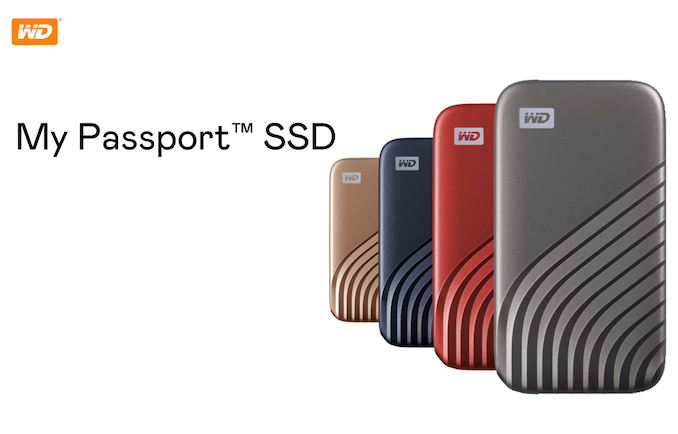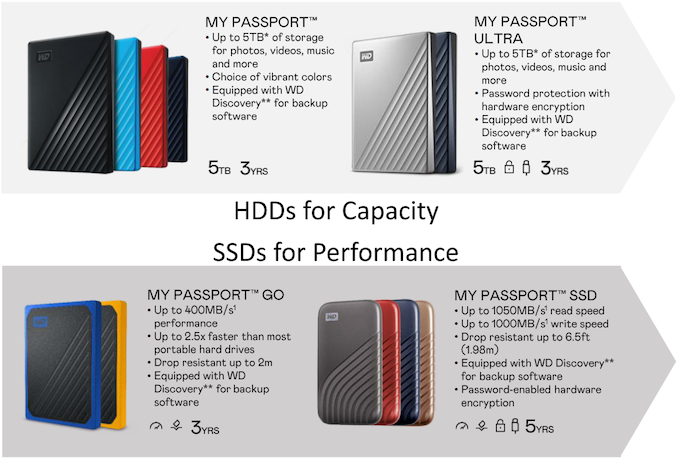Western Digital's USB 3.1 Gen 2 WD My Passport SSD Gets an NVMe Refresh
by Ganesh T S on August 20, 2020 8:00 AM EST- Posted in
- Storage
- SSDs
- Western Digital
- DAS
- Type-C
- My Passport SSD
- USB 3.1 Gen 2

Western Digital's lineup of direct-attached storage (DAS) products targets a range of markets and form-factors. After the acquisition of HGST / G-Technology and SanDisk, the company now offers similar products under multiple brand names. Portable bus-powered SSDs are an example. Subtle differences in the feature sets of the products enhance their appeal to the brand's target market.
Late last year, the WD_Black P50 was introduced as the fastest non-Thunderbolt portable SSD in the market, thanks to its USB 3.2 Gen 2x2 interface. The branding clearly indicated that gamers were the target market. The regular WD branding is reserved for the My Passport series. We reviewed the first model in the My Passport SSD series back in 2017. It used the planar TLC-based SanDisk X400 M.2 SATA SSD internally with a USB 3.1 Gen 2 Type-C host interface. A new version of the My Passport SSD was released the following year with a WD Blue 3D NAND SATA SSD using 64L 3D TLC flash. Both products were held back performance-wise by the use of a SATA SSD. Today's product launch brings NVMe into the picture for the My Passport SSD product line.
The WD My Passport SSD targets productivity use-cases for business professionals (including certain content creators). The new version's industrial design and appearance has changed, with the sharp corners and fully-plastic enclosure now replaced by an aesthetically-pleasing partial metal enclosure having rounded corners. WD claims that the new design feels less rigid and more portable, and has a more pocketable shape overall.
While the WD_Black P50 and the SanDisk Extreme Pro portable SSDs meant for huge games and large media files used the WD Black SN750 NVMe SSD internally, the new WD My Passport uses the DRAM-less WD Blue SN550 NVMe SSD. This still uses a PCIe 3.0 x4 interface, and the performance numbers for the 500GB+ models are good enough to saturate a USB 3.1 Gen 2 interface. Hardware encryption is one of the key features of the higher-end products in the My Passport line-up, and the new My Passport SSD also supports AES-256 for data protection without performance loss.
The WD My Passport SSD 2020 provides a huge leap in performance (up to 1050 MBps) compared to the 2018 version (540 MBps). The 256GB capacity SKU has been phased out, and only three capacities are going to be offered - 500GB ($120), 1TB ($200 - WD's MSRP is $190), and 2TB ($380). While the My Passport SSD 2018 was available only in a single color (gray/black), the 2020 version is available in four colors - gray, red, blue, and gold.
The SanDisk Extreme Pro Portable SSD is our current favorite when it comes to USB 3.1 Gen 2 portable SSDs, thanks to its compact design, performance consistency, and thermal performance. Power consumption (particularly at idle) was one of its Achilles heels compared to the OWC Envoy Pro EX USB-C (which provided similar performance, albeit in a slightly larger form-factor). If the WD My Passport SSD manages to reach close to the SanDisk Extreme Pro's performance profile while also optimizing power consumption, Western Digital may end up with yet another compelling offering in the portable SSD market.
Source: Western Digital













20 Comments
View All Comments
eastcoast_pete - Thursday, August 20, 2020 - link
How warm or hot do these things get? Yes, an SSD doesn't produce that much heat, but after one hour of use, those Wh add up if the heat cannot be vented or radiated out. Especially as NVMe drives tend to run hotter than SATA SSDs.Chaitanya - Thursday, August 20, 2020 - link
Like many external NVME SSDs, hopefully the case is made from metal which will help alleviate some of the heat buildup.quiksilvr - Thursday, August 20, 2020 - link
It's a shame they didn't go Thunderbolt 3. The Samsung X5 is an external NVMe with Thunderbolt 3 and gets 2800 MB/s reads and 2300 MB/s write. This just seems like a waste putting in an NVMe and limiting it to only 10 Gbps when it can do over twice that.Chaitanya - Thursday, August 20, 2020 - link
WD offers thunderbolt SSDs under their G-Technology G-Drive product stack(also their website has a teaser for new G-Drive SSD launching on 3rd Sept).ganeshts - Thursday, August 20, 2020 - link
NVMe (or AHCI, but there are no current controllers supporting that) is the only way to saturate a USB 3.1 Gen 2 link. Thunderbolt 3 is not as widespread as USB Type-C. So, it makes sense that this lineup stays with USB Type-C. WD has other product lines supporting Thunderbolt.Gen-An - Thursday, August 27, 2020 - link
That's the fault of the notebook manufacturers. There's no excuse for a machine that costs $1200+ not to have at least one of its USB-C ports be Thunderbolt 3 (you do know USB-C is just a physical connector, right?).ganeshts - Thursday, August 20, 2020 - link
The SanDisk Extreme Pro 1TB version reached around 60C after continuous writes of up to 90% of the disk capacity. I am expecting the My Passport SSD to behave a bit better, but can't say for sure without a sample in hand.eastcoast_pete - Thursday, August 20, 2020 - link
Thanks Ganesh! 60 C isn't that bad after some serious continued writing load.Valantar - Thursday, August 20, 2020 - link
Have to love how USB-C in and of itself seems to be a premium feature for some manufacturers. Want entry level storage, but with a modern, durable interface? Tough luck!These SSDs look decent enough though. Just hope real world prices turn out okay.
nathanddrews - Thursday, August 20, 2020 - link
Just a guess, but I assume that at scale, Type C hardware is still significantly more expensive than Type A. Type A has been around since... 1996? The scale at which those connectors are produced globally has got to be difficult to displace all at once and most people don't need Type C or know it exists. It's gonna be "premium" for a while I think considering most peripherals are Type A.